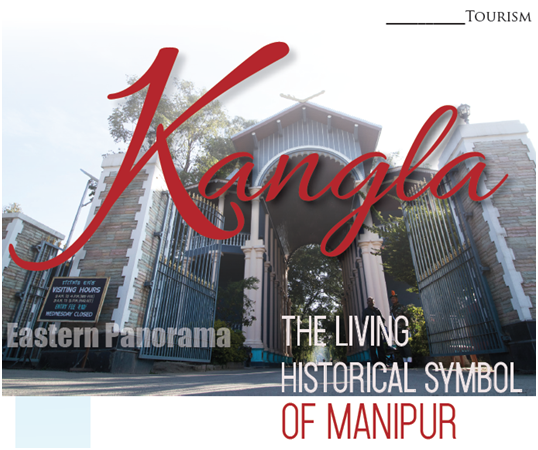Kangla The Living Historical Symbol of Manipur

Kangla, the ancient palatial site of the Kingdom of Manipur, is the symbol of the historical currents of Manipur, majestically, manifesting the process of civilization of the people of Manipur. The very root of her culture and religious beliefs are closely embedded with the growth of Kangla. A revisit into the glorious days and not-so-glorious days of Kangla reveals why it continues to be the very essence of Manipuriness.
Manipur has a proud and long history, dating back to ancient times with Kangla as her capital, in the heart of Imphal, standing as the most sacred place. The recorded history of Manipur began with Kangla. The place emerged as the seat of Power, Justice and Ideals. The importance of Kangla as the political, cultural and ritualistic place is still in the minds of the people.
The significance of Kangla was consolidated with the emergence of Nongda Lairen Pakhangba, the first historical King of Manipur in the year 33 A.D. The growth of the Ningthouja dynasty under his leadership and the continuity of the rule of Manipur under this dynasty for more than two thousand years is the unique feature of Kangla.
Kangla Men Surung is the most important place of Kangla where the coronation ceremony or the ‘Men Tongba’ of the Kings of Manipur was performed with elaborate cultural and ritualistic practices. According to the tradition, the coronation throne was kept over a small, opening mouth of the cave and the King had to sit on the throne. The opening mouth of the cave is known as the ‘Kangla Men Surung’. The area around the cave is portrait in the archaic Manipuri as the ‘Thon Taret Thollangmei’, meaning the seven-layered ground.
ceremony or the ‘Men Tongba’ of the Kings of Manipur was performed with elaborate cultural and ritualistic practices. According to the tradition, the coronation throne was kept over a small, opening mouth of the cave and the King had to sit on the throne. The opening mouth of the cave is known as the ‘Kangla Men Surung’. The area around the cave is portrait in the archaic Manipuri as the ‘Thon Taret Thollangmei’, meaning the seven-layered ground.
The concept of seven layers is closely associated with mythological notions of the growth of Kangla. It is the general belief that Taoroinai Pakhangba resides underneath in the coiled form called ‘Paphal’. Each and every layers are represented by different characteristic features such as a python, a tortoise, a boar, an ox, an elephant and a super natural being. It is belief that these elements carry the ‘Paphal’ and located just below the coronation hall.
Kangla gradually grew as a formidable fortress city over the centuries. A major landmark in the growth of Kangla fortress was the massive construction by King Khagemba in the 16th century.
The Citadel, which housed the royal residence, was the nerve administration. Five walls surrounded the royal palace. The innermost wall is the only structure that remains standing today. Each corners of the wall were interspersed with octagonal shaped watchtowers, serving as sentry posts. The entire perimeter of the Citadel had emplacements for upto 500 defenders.
To the south west of the Citadel was the Kangjeibung or pologround, known as the Manung Kangjeibung or the inner polo ground. Polo’s origin can be traced back from the time of King Kangba. Ancient literary sources mention Sagol Kangei or Pana Kangjei as the “Game of the Gods”. Today Polo is the national sport of Manipur. Joe Sherer, a British Major General was so impressed by the game that he took Manipuri polo players to Calcutta and introduced Polo to the world in an exhibition match in 1863.
The fortification and beautification of Kangla was improved by King Khunjaoba. The moat surrounding the three sides of the Kangla was dug during 1660 A.D. Its primary purpose was to defend Kangla against marauding enemies. In the early period of time, the moat was used for Hiyang Tannaba or boat race.
Due to the repeated Burmese invasion, the Kings of Manipur was forced to leave Kangla. Rajashree Bheigyachandra shifted his capital to Canchipur. From 1819 to 1826 Manipur was under the control of Burmese for seven years. This period was called the “Chahi Taret Khun Takpa” or the Seven Years Devastation.
Maharaj Nara Singh shifted the capital back to the Kangla in 1844 A.D. From his time, Kangla witnessed the emergence of Hindu architecture. The constructions of the temple of Shree Govindaji, Lord Brindavan Chandra, Mandap, Beithop, etc. are best examples.
The Shree Shree Govindajee temple and the Beithop are significant not only as a religious symbol but also as the focal point of socio-cultural activities.
Another noteworthy structure of Hindu architecture in Kangla is the temple of Lord Brindavan Chandra, which was always under the care of ‘Yuvaraj’. It was built like a fort, exquisite arch entrances adorn the four sides of the temple, giving no indication of the mysteries therein.
Sunzu Bachaspatimayum
To read the further article please get your copy of Eastern Panorama January issue @http://www.magzter.com/IN/Hill-Publications/Eastern-Panorama/News/ or mail to contact @easternpanorama.in

